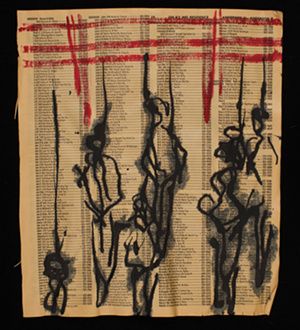Torn from a phonebook, Whitepages containing hundreds of names from Cincinnatian and Northern Kentuckians line a wall of the Skirball Museum. Each page is framed in black, worn and browned, with their edges curling forward. On top, black paint is interspersed with red.
The exhibition — titled Hanging Figures — was created in response to the Holocaust by local artist Stewart Goldman. Despite making the series in the ’90s, Goldman's works (12 in total) are just now getting their gallery debut.
As explained in his artist statement, Goldman recalls visiting Munich, Germany in the ’90s to visit a friend. There, he passed by the Akademie der Bildenden Künste — Munich's Academy of Fine Arts — and saw the names of several German artists painted on large windows. He only remembers two: “Max Liebermann, a Jewish artist and former president of the Prussian Academy of Arts (1920-1933) who campaigned for the separation of art and politics; and Käthe Kollwitz, head of the Master Studio for Graphic Arts (1928-1933), a printmaker and sculptor whose imagery described significant humanitarian issues on war and poverty.”
By 1933, the Nazis had forced both to resign from the academy.
Later he would return to visit the 1998 exhibition, War of Extermination: Crimes of the Wehrmacht, which had just opened; it referenced crimes committed by the regular German Army, the Wehrmacht, on the Eastern Front, and sought to dispell myths that the army fought with honor. When Goldman visited on its opening day, protests fronted by neo-Nazi groups had unfolded; the exhibition itself was criticized as “a moral campaign of destruction against the German Volk (people),” according to a press release.
It revealed photographs and documents that tied the Wehrmacht to having active participation in atrocities against Jews, civilians in Serbia and the Soviet Union and prisoners of war.
Hanging Figures coincides with Genocide Awareness and Prevention Month; it also lines up with Holocaust Remembrance Day on May 1-2 and closes June 2.
“They indirectly coincide with other images I've done in the sense that these are on phone book pages and it came with, essentially, a belief that something like this can happen in another time, another place,” Goldman says of this series. “The public sphere is open for these things to happen.”
The aforementioned lifeless figures are depicted in jarring, simple strokes — hanging from balconies, barns and other structures.
In partnership with the Holocaust and Humanity Center at Union Terminal, the Center’s director of education, Jodi Elowitz, will speak at the exhibit’s opening on art in response to the Holocaust as it relates to different perspectives: Those who survived it and those who empathize. (The exhibit is also supported by the Carol Ann and Ralph V. Haile/US Bank Foundation.)
“Stewart didn't experience the Holocaust,” says Abby Schwartz, the Skirball’s director. “We have very few people left in the world who did. In the next decade, there won't be any because even the youngest children who survived are now in their 80s and 90s. And — with very few exceptions — they'll be passing away.”
But artists are still addressing the topic, she says, in terms of their own personal relationship to it. Whether they have a family connection — like Stewart, whose grandmother was a survivor — or no apparent ties.
“We are at a place in our society where everything is falling into the places where we were with Germany, where this could happen again,” she says. “So art is one of the ways of expressing that. That fear, that concern, that trepidation.”
In part, the work of the Holocaust and Humanity Centers seeks to educate the greater community about the atrocities of the Holocaust, as well as other genocides. Schwartz notes that, as these events stretch farther down in history, the more important it is for the stories to be told, "so that it doesn't happen again."
"That experience has to be communicated," Goldman says. "And made understood to young people."
Seen as a whole — standing from afar — the shapes of the figures feel abstract and, strangely, overwhelming. Come closer and their bodies become more distinct, as do the names in the background. It's a compelling and moving series that tells a greater story — one that should be heard, time and time again.
Hanging Figures opens at the Skirball Museum (3101 Clifton Ave., Clifton) on April 11 with an opening reception at 5:30 p.m. and runs through June 1.


